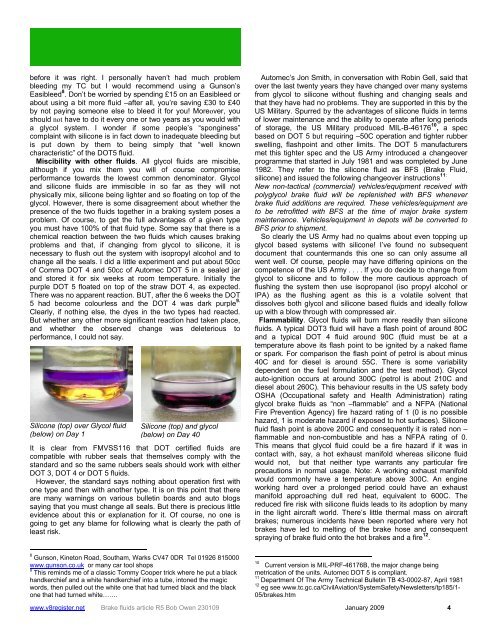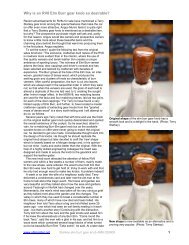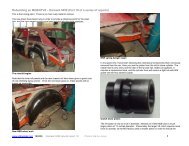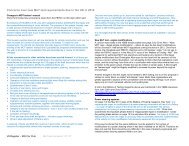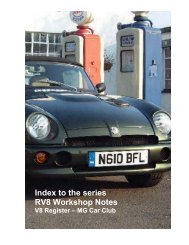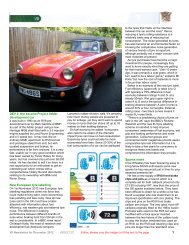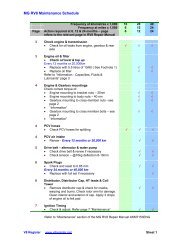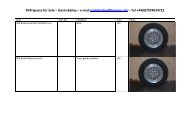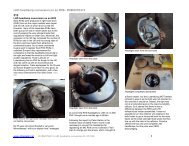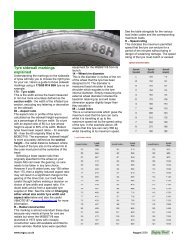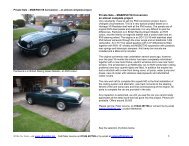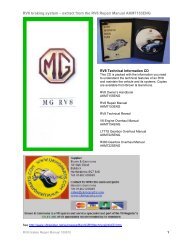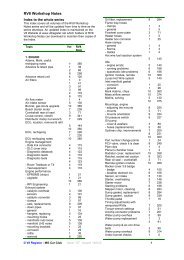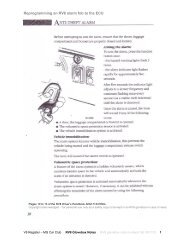Which brake fluid? What do DOT3, DOT4 and DOT 5 ... - V8 Register
Which brake fluid? What do DOT3, DOT4 and DOT 5 ... - V8 Register
Which brake fluid? What do DOT3, DOT4 and DOT 5 ... - V8 Register
Create successful ePaper yourself
Turn your PDF publications into a flip-book with our unique Google optimized e-Paper software.
efore it was right. I personally haven’t had much problem<br />
bleeding my TC but I would recommend using a Gunson’s<br />
Easibleed 8 . Don’t be worried by spending £15 on an Easibleed or<br />
about using a bit more <strong>fluid</strong> –after all, you’re saving £30 to £40<br />
by not paying someone else to bleed it for you! Moreover, you<br />
should not have to <strong>do</strong> it every one or two years as you would with<br />
a glycol system. I wonder if some people’s “sponginess”<br />
complaint with silicone is in fact <strong>do</strong>wn to inadequate bleeding but<br />
is put <strong>do</strong>wn by them to being simply that “well known<br />
characteristic” of the <strong>DOT</strong>5 <strong>fluid</strong>.<br />
Miscibility with other <strong>fluid</strong>s. All glycol <strong>fluid</strong>s are miscible,<br />
although if you mix them you will of course compromise<br />
performance towards the lowest common denominator. Glycol<br />
<strong>and</strong> silicone <strong>fluid</strong>s are immiscible in so far as they will not<br />
physically mix, silicone being lighter <strong>and</strong> so floating on top of the<br />
glycol. However, there is some disagreement about whether the<br />
presence of the two <strong>fluid</strong>s together in a braking system poses a<br />
problem. Of course, to get the full advantages of a given type<br />
you must have 100% of that <strong>fluid</strong> type. Some say that there is a<br />
chemical reaction between the two <strong>fluid</strong>s which causes braking<br />
problems <strong>and</strong> that, if changing from glycol to silicone, it is<br />
necessary to flush out the system with isopropyl alcohol <strong>and</strong> to<br />
change all the seals. I did a little experiment <strong>and</strong> put about 50cc<br />
of Comma <strong>DOT</strong> 4 <strong>and</strong> 50cc of Automec <strong>DOT</strong> 5 in a sealed jar<br />
<strong>and</strong> stored it for six weeks at room temperature. Initially the<br />
purple <strong>DOT</strong> 5 floated on top of the straw <strong>DOT</strong> 4, as expected.<br />
There was no apparent reaction. BUT, after the 6 weeks the <strong>DOT</strong><br />
5 had become colourless <strong>and</strong> the <strong>DOT</strong> 4 was dark purple 9.<br />
Clearly, if nothing else, the dyes in the two types had reacted.<br />
But whether any other more significant reaction had taken place,<br />
<strong>and</strong> whether the observed change was deleterious to<br />
performance, I could not say.<br />
Silicone (top) over Glycol <strong>fluid</strong><br />
(below) on Day 1<br />
Silicone (top) <strong>and</strong> glycol<br />
(below) on Day 40<br />
It is clear from FMVSS116 that <strong>DOT</strong> certified <strong>fluid</strong>s are<br />
compatible with rubber seals that themselves comply with the<br />
st<strong>and</strong>ard <strong>and</strong> so the same rubbers seals should work with either<br />
<strong>DOT</strong> 3, <strong>DOT</strong> 4 or <strong>DOT</strong> 5 <strong>fluid</strong>s.<br />
However, the st<strong>and</strong>ard says nothing about operation first with<br />
one type <strong>and</strong> then with another type. It is on this point that there<br />
are many warnings on various bulletin boards <strong>and</strong> auto blogs<br />
saying that you must change all seals. But there is precious little<br />
evidence about this or explanation for it. Of course, no one is<br />
going to get any blame for following what is clearly the path of<br />
least risk.<br />
8 Gunson, Kineton Road, Southam, Warks CV47 0DR Tel 01926 815000<br />
www.gunson.co.uk or many car tool shops<br />
9 This reminds me of a classic Tommy Cooper trick where he put a black<br />
h<strong>and</strong>kerchief <strong>and</strong> a white h<strong>and</strong>kerchief into a tube, intoned the magic<br />
words, then pulled out the white one that had turned black <strong>and</strong> the black<br />
one that had turned white…….<br />
Automec’s Jon Smith, in conversation with Robin Gell, said that<br />
over the last twenty years they have changed over many systems<br />
from glycol to silicone without flushing <strong>and</strong> changing seals <strong>and</strong><br />
that they have had no problems. They are supported in this by the<br />
US Military. Spurred by the advantages of silicone <strong>fluid</strong>s in terms<br />
of lower maintenance <strong>and</strong> the ability to operate after long periods<br />
of storage, the US Military produced MIL-B-46176 10 , a spec<br />
based on <strong>DOT</strong> 5 but requiring –50C operation <strong>and</strong> tighter rubber<br />
swelling, flashpoint <strong>and</strong> other limits. The <strong>DOT</strong> 5 manufacturers<br />
met this tighter spec <strong>and</strong> the US Army introduced a changeover<br />
programme that started in July 1981 <strong>and</strong> was completed by June<br />
1982. They refer to the silicone <strong>fluid</strong> as BFS (Brake Fluid,<br />
silicone) <strong>and</strong> issued the following changeover instructions 11:<br />
New non-tactical (commercial) vehicles/equipment received with<br />
polyglycol <strong>brake</strong> <strong>fluid</strong> will be replenished with BFS whenever<br />
<strong>brake</strong> <strong>fluid</strong> additions are required. These vehicles/equipment are<br />
to be retrofitted with BFS at the time of major <strong>brake</strong> system<br />
maintenance. Vehicles/equipment in depots will be converted to<br />
BFS prior to shipment.<br />
So clearly the US Army had no qualms about even topping up<br />
glycol based systems with silicone! I’ve found no subsequent<br />
<strong>do</strong>cument that counterm<strong>and</strong>s this one so can only assume all<br />
went well. Of course, people may have differing opinions on the<br />
competence of the US Army . . . . If you <strong>do</strong> decide to change from<br />
glycol to silicone <strong>and</strong> to follow the more cautious approach of<br />
flushing the system then use isopropanol (iso propyl alcohol or<br />
IPA) as the flushing agent as this is a volatile solvent that<br />
dissolves both glycol <strong>and</strong> silicone based <strong>fluid</strong>s <strong>and</strong> ideally follow<br />
up with a blow through with compressed air.<br />
Flammability. Glycol <strong>fluid</strong>s will burn more readily than silicone<br />
<strong>fluid</strong>s. A typical <strong><strong>DOT</strong>3</strong> <strong>fluid</strong> will have a flash point of around 80C<br />
<strong>and</strong> a typical <strong>DOT</strong> 4 <strong>fluid</strong> around 90C (<strong>fluid</strong> must be at a<br />
temperature above its flash point to be ignited by a naked flame<br />
or spark. For comparison the flash point of petrol is about minus<br />
40C <strong>and</strong> for diesel is around 55C. There is some variability<br />
dependent on the fuel formulation <strong>and</strong> the test method). Glycol<br />
auto-ignition occurs at around 300C (petrol is about 210C <strong>and</strong><br />
diesel about 260C). This behaviour results in the US safety body<br />
OSHA (Occupational safety <strong>and</strong> Health Administration) rating<br />
glycol <strong>brake</strong> <strong>fluid</strong>s as “non –flammable” <strong>and</strong> a NFPA (National<br />
Fire Prevention Agency) fire hazard rating of 1 (0 is no possible<br />
hazard, 1 is moderate hazard if exposed to hot surfaces). Silicone<br />
<strong>fluid</strong> flash point is above 200C <strong>and</strong> consequently it is rated non –<br />
flammable <strong>and</strong> non-combustible <strong>and</strong> has a NFPA rating of 0.<br />
This means that glycol <strong>fluid</strong> could be a fire hazard if it was in<br />
contact with, say, a hot exhaust manifold whereas silicone <strong>fluid</strong><br />
would not, but that neither type warrants any particular fire<br />
precautions in normal usage. Note: A working exhaust manifold<br />
would commonly have a temperature above 300C. An engine<br />
working hard over a prolonged period could have an exhaust<br />
manifold approaching dull red heat, equivalent to 600C. The<br />
reduced fire risk with silicone <strong>fluid</strong>s leads to its a<strong>do</strong>ption by many<br />
in the light aircraft world. There’s little thermal mass on aircraft<br />
<strong>brake</strong>s; numerous incidents have been reported where very hot<br />
<strong>brake</strong>s have led to melting of the <strong>brake</strong> hose <strong>and</strong> consequent<br />
spraying of <strong>brake</strong> <strong>fluid</strong> onto the hot <strong>brake</strong>s <strong>and</strong> a fire 12 .<br />
10<br />
Current version is MIL-PRF-46176B, the major change being<br />
metrication of the units. Automec <strong>DOT</strong> 5 is compliant.<br />
11<br />
Department Of The Army Technical Bulletin TB 43-0002-87, April 1981<br />
12<br />
eg see www.tc.gc.ca/CivilAviation/SystemSafety/Newsletters/tp185/1-<br />
05/<strong>brake</strong>s.htm<br />
www.v8register.net Brake <strong>fluid</strong>s article R5 Bob Owen 230109 January 2009 4


